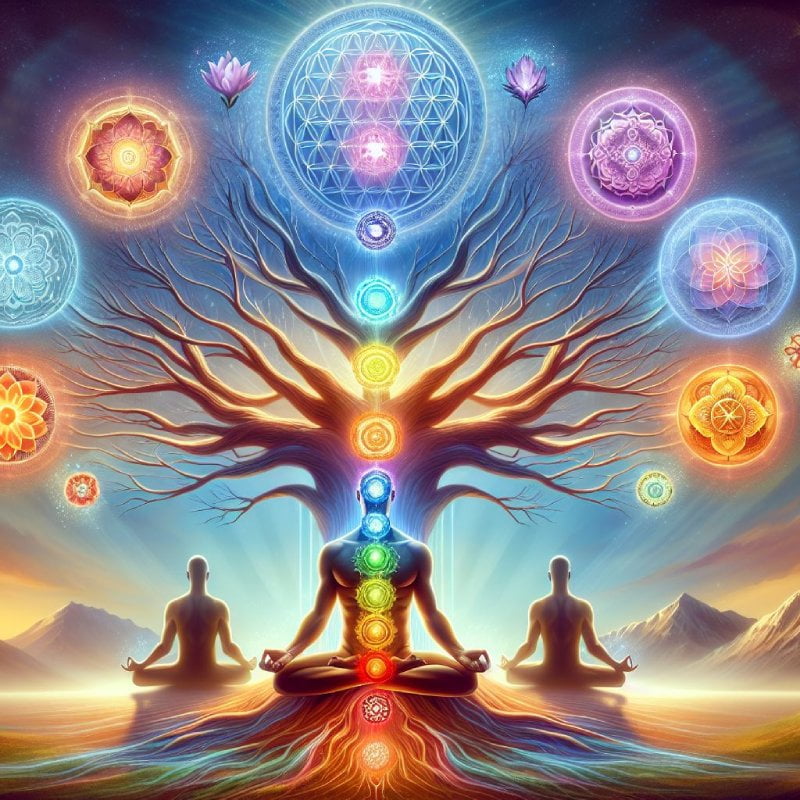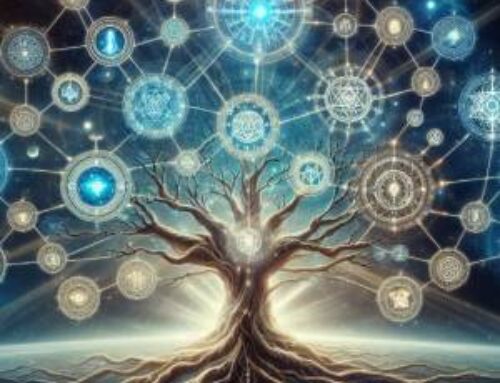Contents
- 1 Introduction
- 2 Nevertheless according to teachings one can return to Eden through growth and inner change.
- 3 The Tree of Life and the Tree of Knowledge in Kabbalistic Beliefs
- 4 The Role of the Serpent in Kabbalah
- 5 FAQ- Kabbalah Adam and Eve
- 5.1 1. What does Kabbalah Adam and Eve symbolize in beliefs?
- 5.2 2. How does the symbolism of the Tree of Life intertwine with the tale of Adam and Eve?
- 5.3 3. What significance does the serpent hold in interpretation?
- 5.4 4. How can delving into Adam and Eves story in Kabbalah contribute to advancement?
- 5.5 5. What educational materials are available from Hermetic Academy, for learning about Kabbalah?
- 6 References:
Introduction
In the teachings of Kabbalah, the narrative of Adam and Eve goes beyond a tale. It offers insights, into human life and the divine essence. This ancient story, rooted in the Hebrew Bible is not about temptation and downfall. Holds hidden meanings that reflect the complexities of the human soul the interaction of masculine and feminine energies and our journey towards spiritual enlightenment.

Viewing Kabbalah Adam and Eve through a lens allows us to ponder lifes mysteries. It unravels the symbolism of Edens Garden, the Tree of Life and the Tree of Knowledge – each symbolizing aspects of human consciousness. Exploring these symbols reveals a wealth of wisdom that helps us understand ourselves better within the universe.
The tale of Kabbalah Adam and Eve is more than a recounting of humanitys beginning; it signifies a struggle between opposing forces within ourselves. It speaks to our potential, for development by balancing these forces to reach our self.
According to this doctrine, the absolute is Being and therein is the Word which expresses the reason of Being and of life (1).
As we delve into the teachings of Kabbalah surrounding Adam and Eve we uncover truths that deeply resonate with our inner selves and shed light on the path to spiritual fulfillment. The Symbolism of Adam and Eve, in Kabbalistic Beliefs as Universal Symbols In the realm of Kabbalah, Adam and Eve are viewed as symbols embodying facets of the human soul.
Adam represents the essence within humanity signifying the potential for enlightenment and unity with the divine realm. Conversely Eve embodies our nature, rooted in the material world and confronted with temptations and obstacles. The symbolism of Eve being created from Adams rib reflects the transition from unity to duality a core concept in philosophy. This duality is essential for creation to unfold facilitating an interplay between masculine and feminine energies, spiritual and material realms, conscious and unconscious aspects.
The separation followed by reunion of these elements forms a part of Kabbalistic teachings on humanitys journey towards completeness. The Fall, from Grace; A Kabbalistic Perspective The narrative of Adam and Eves fall from grace in Genesis holds importance in interpretations.
God is the all-working; He is the effect of Nature, working for the perfecting of the Universe. (Book II: To Asclepius) (2).
The act of eating from the Tree of Knowledge of Good and Evil is not just seen as disobedience. As a crucial step, in the development of human awareness. Adam and Eves choice leads them to understand the dualities in life, such as good versus evil, pleasure versus pain.
The Role of Evil: Evil is considered a necessary aspect of creation, providing a counterbalance that allows for free will and growth (3).
This newfound awareness brings both a sense of downfall and an opportunity for redemption. It introduces the idea of will giving humanity the ability to make choices between lower paths. The journey into the material world despite its difficulties and hardships presents a chance for progress and eventual reunion with the source. The ultimate aim is to transform knowledge into wisdom seeking balance and harmony.
The story of Eden symbolizes a state of purity and potential within each individual. It represents a connection to the presence. Serves as a goal for those on a spiritual quest. The expulsion from Eden signifies losing this state and embarking on a journey, through lifes challenges.
Nevertheless according to teachings one can return to Eden through growth and inner change.
By embracing the will and nurturing qualities, like love, compassion and wisdom we can reconnect with the essence of the Garden. Embrace the profound presence of divinity. This transformative journey involves aligning our desires with purity and our intentions with clarity guiding us towards a state of oneness and balance with the divine.
The Tree of Life and the Tree of Knowledge in Kabbalistic Beliefs
Within the narrative of the Garden of Eden two symbolic trees hold meaning; the Tree of Life and the Tree of Knowledge representing Good and Evil. These trees are not entities but symbols deeply embedded in Kabbalistic philosophy (4). The Tree of Life symbolizes sefirot – ten emanations that embody presence in our world representing order and spiritual progression.
Conversely the Tree of Knowledge signifies duality and material existence. Partaking from this tree unveils an understanding of dualities defining our experiences. While this awareness fosters free will development and moral judgment it also introduces complexities leading to conflicts and suffering. The dynamic interplay between these two symbolic trees mirrors humanitys struggle between unity versus duality, spirituality, versus materialism shaping our journey.
The Tree of Life, with its ten sefirot acts as a guide to understanding consciousness and spiritual growth. Each sefirot symbolizes an aspect of the divine and a step in the quest for enlightenment. For instance Kether signifies the pinnacle of awareness while Malkuth embodies the realm.
When Kabbalah Adam and Eve interacted with the Tree of Knowledge of Good and Evil it can be viewed as a journey into the sefirot, where duality and material existence prevail. The goal for seekers is to ascend through the Tree of Life progressing from sefirot to higher ones ultimately reaching back to Kethers unity. This ascent requires integrating and balancing facets of oneself to achieve wholeness and oneness with the divine.
Looking at Kabbalah Adam and Eves story through a lens reveals a narrative of decline and redemption. It depicts the shift from unity to duality. Back again—a reflection of the nature inherent in spiritual growth. Redemption entails acknowledging and transcending dualities that shape our lives such as good versus evil, pleasure versus pain and material, versus realms.
By practicing Kabbalah people can develop qualities, like wisdom, insight and kindness needed for this journey. By following the will and embracing the teachings of Kabbalah we can navigate lifes complexities. Reach a state of spiritual enlightenment. The ultimate aim is to return to a state to the Garden of Eden where we can feel the divine presence fully and bask in eternal love.
The Role of the Serpent in Kabbalah
The Serpent as a Symbol of Change
In beliefs the serpent in the Garden of Eden isn’t a tempter but also signifies transformation and growth. It symbolizes the forces that push us towards progress despite challenges. It embodies temptation, which though leading to downfall also offers redemption and enlightenment opportunities.
The serpents purpose is to trigger self awareness and awaken potential. Kabbalah Adam and Eves yielding to temptation sets them on a path of self discovery and spiritual growth. The obstacles they encounter due to their choices become stones, toward consciousness levels and divine connection.
The idea of temptation plays a role in the perspective, on spiritual development. Than being viewed as negative temptation is considered an essential part of ones spiritual path. It offers individuals opportunities to confront their desires and surpass them leading to increased self control and spiritual enlightenment.
The story of Adam and Eve succumbing to temptation highlights the journey of facing and conquering ones ego. It serves as a reminder that spiritual progress often involves addressing our struggles and elevating our urges into loftier aspirations. In this narrative the serpent acts as a guide urging us to transcend our limitations and recognize our potential.
A crucial message drawn from the Adam and Eve tale in Kabbalah is the importance of transcending duality. The dual nature represented by the Tree of Knowledge of Good and Evil symbolizes the experience. To attain unity akin, to that of the Tree of Life we must move beyond these divisions. Embrace our selves.
Achieving this integration entails balancing both masculine and feminine qualities within ourselves mirrored by Adam and Eve. It calls for aligning our endeavors with material pursuits harmonizing our conflicts and unifying our inner world with external realities.
By following this path we can find peace. Connect with a higher power leading us back, to a place of unity and balance similar to the Garden of Eden.
In summary the Kabbalistic interpretation of Adam and Eve offers an understanding of this tale. It uncovers truths within the narrative. Provides insights into human existence and the pursuit of enlightenment. By delving into these teachings we can better grasp our potential and the transformative effects of practice.
The story of Kabbalah Adam and Eve serves as a reminder that we are all evolving spiritually. Through Kabbalah we can navigate lifes challenges. Attain a state of unity and lasting happiness. The Hermetic Academy offers resources for individuals looking to explore Kabbalah and begin their journey.
FAQ- Kabbalah Adam and Eve
1. What does Kabbalah Adam and Eve symbolize in beliefs?
A: In teachings Adam and Eve symbolize the two aspects of the soul as it moves from unity to duality and back, to unity again. Their narrative showcases the journey, towards development and the capacity for enlightenment by harmonizing aspects within ourselves.
2. How does the symbolism of the Tree of Life intertwine with the tale of Adam and Eve?
A: In Kabbalah the Tree of Life symbolizes harmony and the path to elevation. The involvement of Adam and Eve with the Tree of Knowledge of Good and Evil signifies their descent into duality and material existence. The objective is to ascend along the Tree of Life towards unity with Kether representing the level of awareness.
3. What significance does the serpent hold in interpretation?
A: Within teachings the serpent serves as a representation of transformation and evolution. It embodies the obstacles and allurements that push us towards progress and self realization. The serpents purpose is to spark awakening and prompt recognition of our capabilities.
4. How can delving into Adam and Eves story in Kabbalah contribute to advancement?
A: Exploring Adam and Eves narrative in a context offers insights into human consciousness dynamics and spiritual evolution. It underscores integrating conflicting elements within ourselves while surpassing dualities to reach a state of unity and enlightenment.
5. What educational materials are available from Hermetic Academy, for learning about Kabbalah?
A: The Hermetic Academy provides a variety of options, for exploring Kabbalah, such as books, webinars, videos, guided meditations, initiations and courses. These offerings offer assistance and encouragement for those, in delving into the teachings of Kabbalah and starting a meaningful spiritual exploration.
References:
(1) Eliphas, L. (1854). Dogme et Rituel de la Haute Magie. Paris.
(2) Ficino, M. (1471). Corpus Hermeticum. Florenz
(3) Mathers, S. L. M. (1887). The Kabbalah Unveiled. London.
(4) Rubenstein, E. (2020). The Tree of Life: The Kabbalah of Immortality. Hermetic World, Paphos.





